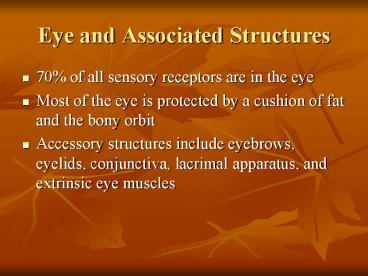Eye and Associated Structures PowerPoint PPT Presentation
1 / 25
Title: Eye and Associated Structures
1
Eye and Associated Structures
- 70 of all sensory receptors are in the eye
- Most of the eye is protected by a cushion of fat
and the bony orbit - Accessory structures include eyebrows, eyelids,
conjunctiva, lacrimal apparatus, and extrinsic
eye muscles
2
Eyebrows
- Coarse hairs that overlie the supraorbital
margins - Functions include
- Shading the eye
- Preventing perspiration from reaching the eye
- Orbicularis muscle depresses the eyebrows
- Corrugator muscles move the eyebrows medially
3
Palpebrae (Eyelids)
- Protect the eye anteriorly
- Palpebral fissure separates eyelids
- Canthi medial and lateral angles (commissures)
4
Palpebrae (Eyelids)
- Lacrimal caruncle contains glands that secrete
a whitish, oily secretion (Sandmans eye sand) - Tarsal plates of connective tissue support the
eyelids internally - Levator palpebrae superioris gives the upper
eyelid mobility
5
Palpebrae (Eyelids)
- Eyelashes
- Project from the free margin of each eyelid
- Initiate reflex blinking
- Lubricating glands associated with the eyelids
- Meibomian glands and sebaceous glands
- Ciliary glands lie between the hair follicles
6
Palpebrae (Eyelids)
Figure 15.1b
7
Conjunctiva
- Transparent membrane that
- Lines the eyelids as the palpebral conjunctiva
- Covers the whites of the eyes as the ocular
conjunctiva - Lubricates and protects the eye
8
Lacrimal Apparatus
- Consists of the lacrimal gland and associated
ducts - Lacrimal glands secrete tears
- Tears
- Contain mucus, antibodies, and lysozyme
- Enter the eye via superolateral excretory ducts
- Exit the eye medially via the lacrimal punctum
- Drain into the nasolacrimal duct
9
Lacrimal Apparatus
Figure 15.2
10
Extrinsic Eye Muscles
- Six straplike extrinsic eye muscles
- Enable the eye to follow moving objects
- Maintain the shape of the eyeball
- Four rectus muscles originate from the annular
ring - Two oblique muscles move the eye in the vertical
plane
11
Extrinsic Eye Muscles
Figure 15.3a, b
12
Summary of Cranial Nerves and Muscle Actions
- Names, actions, and cranial nerve innervation of
the extrinsic eye muscles
Figure 15.3c
13
Structure of the Eyeball
- A slightly irregular hollow sphere with anterior
and posterior poles - The wall is composed of three tunics fibrous,
vascular, and sensory - The internal cavity is filled with fluids called
humors - The lens separates the internal cavity into
anterior and posterior segments
14
Structure of the Eyeball
Figure 15.4a
15
Fibrous Tunic
- Forms the outermost coat of the eye and is
composed of - Opaque sclera (posteriorly)
- Clear cornea (anteriorly)
- The sclera protects the eye and anchors extrinsic
muscles - The cornea lets light enter the eye
16
Vascular Tunic (Uvea) Choroid Region
- Has three regions choroid, ciliary body, and
iris - Choroid region
- A dark brown membrane that forms the posterior
portion of the uvea - Supplies blood to all eye tunics
17
Vascular Tunic Ciliary Body
- A thickened ring of tissue surrounding the lens
- Composed of smooth muscle bundles (ciliary
muscles) - Anchors the suspensory ligament that holds the
lens in place
18
Vascular Tunic Iris
- The colored part of the eye
- Pupil central opening of the iris
- Regulates the amount of light entering the eye
during - Close vision and bright light pupils constrict
- Distant vision and dim light pupils dilate
- Changes in emotional state pupils dilate when
the subject matter is appealing or requires
problem-solving skills
19
Pupil Dilation and Constriction
Figure 15.5
20
Sensory Tunic Retina
- A delicate two-layered membrane
- Pigmented layer the outer layer that absorbs
light and prevents its scattering - Neural layer, which contains
- Photoreceptors that transduce light energy
- Bipolar cells and ganglion cells
- Amacrine and horizontal cells
21
Sensory Tunic Retina
Figure 15.6a
22
The Retina Ganglion Cells and the Optic Disc
- Ganglion cell axons
- Run along the inner surface of the retina
- Leave the eye as the optic nerve
- The optic disc
- Is the site where the optic nerve leaves the eye
- Lacks photoreceptors (the blind spot)
23
The Retina Ganglion Cells and the Optic Disc
Figure 15.6b
24
The Retina Photoreceptors
- Rods
- Respond to dim light
- Are used for peripheral vision
- Cones
- Respond to bright light
- Have high-acuity color vision
- Are found in the macula lutea
- Are concentrated in the fovea centralis
25
Blood Supply to the Retina
- The neural retina receives its blood supply from
two sources - The outer third receives its blood from the
choroid - The inner two-thirds is served by the central
artery and vein - Small vessels radiate out from the optic disc and
can be seen with an ophthalmoscope

